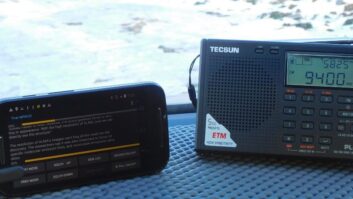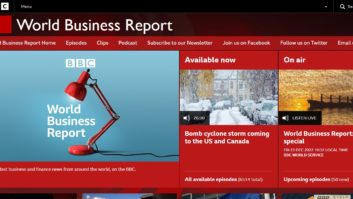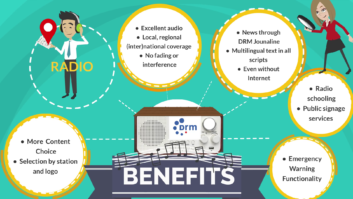Guy Defends His Proposals to Thin the Population of a ‘Herd Full of Cripples’
I’ve received numerous comments from readers on my column about saving the AM band, some of which appear in this issue of Radio World Engineering Extra.
It’s always good to read and consider the many cogent and insightful observations of fellow engineers who care deeply about radio’s future and well-being.
We hear a lot of criticism that profit-minded broadcasters have brought the current AM conundrum on themselves by insisting that more and more stations be crammed into an already crowded bandscape. The FCC is just as culpable by enabling the abuse, and now with HD Radio, the situation will only become much worse.
It’s easy to cite the problems and the reasons solutions seem difficult and elusive. Yet I see few others stepping forward, as I have, to offer constructive ideas that just might help extricate us from the mess.
My proposal that the band needs to be thinned out and cleaned up is hardly a back-room conspiracy inspired by mega-groups to drive small-market operators out of business, as some respondents suggest. It’s rather about brainstorming an equitable plan to help the industry as a whole as well as those AM operators who are struggling to stay in business by offering them reasonable options.
These would either allow them to continue with their broadcasting enterprises using an alternative LPFM service, or at least provide them something of value in exchange for retiring their licenses. The existing stations that are economically viable and continue to provide local community service will most certainly have the opportunity to remain as they are. But most would agree such stations are in a dwindling minority.
STATION NUMBERS ARE UNCHANGED
Granted, AM stations are allocated on a demand basis and can be bought out of existence now, as some have. But there is no evidence of any ongoing natural attrition process that will thin the AM band on its own.
For every station that goes dark, a daytimer adds nighttime or increases power, or a new rimshot allocation is shoehorned in someplace. The number of AM stations in the United States actually has remained almost constant over 15 years, fluctuating between 5,000 and 4,700.
Even in the face of high conversion costs and the inability of many smaller AMs to afford adding HD Radio, the number of stations will not likely drop rapidly enough to allow for significant interference mitigation and a rebirth for AM with full-time HD.
It will no doubt be many years before such stations would be forced into deciding between going digital or going dark, unless mandated by the commission. If anything, the advent of multichannel HD-FM will drive the do-or-die economic issue more directly as formats carried on narrow-casted AMs migrate to multichannel HD-FMs.
The AM band clearly is a herd full of cripples and has been for a very long time. In order to create a cleaner band so that surviving stations can fully leverage the benefits of HD to attract significant audiences with competitive service both day and night, the marginal members need to be thinned out more quickly.
As long as there are buyers — mostly religious and ethnic, who want to serve small audiences — and as long as there remains the tenuous hope that HD Radio will somehow transform all AMs into high-fidelity head-to-head music competition with FMs, there is no incentive for owners to give up or turn in their licenses. Most will just hang onto them for tax-loss benefits, or sell to other narrow-casters to recoup as much of their investments as they can. And from there, the cycle just keeps repeating.
HD CONVERSION IS NOT THE TOTAL ANSWER
What many owners of marginal AM facilities might be overlooking is the plain and simple fact that adding the benefit of HD Radio will not fix deficient coverage problems. It could shrink coverage in many cases.
While most AM stations are not bothered by interference from other stations during the day, maintaining their coverage at night is heavily undermined by the onslaught of skywave. Even if an AM station has decent daytime market coverage, but its nighttime coverage shrinks dramatically, as many do, its ability to compete with FM stations and other AM stations that cover their markets well at all hours is severely compromised. Unless an AM station has solid full-time coverage of its target area or market, it’s not going to be a player in the new era.
HD deployment has accelerated nicely for FM but has lagged badly for AM. There’s a good reason most AM owners have not stepped up and made commitments to add HD Radio. Even without authority to use HD at night just yet, AM operators understandably are apprehensive about what’s going to happen with increased interference and the probability other stations will file complaints forcing them to reduce digital power or turn off HD Radio at night. Unless you can run it full-time, the risks of committing to HD now are just too high for too many. What is needed is a cleaner environment in which concern about interference issues is not so overriding.
The remedies I propose would promote more attractive incentives for marginal station owners to sell and/or go dark; such remedies simply are not available now.
The first would be to establish new rules to allow trading in an AM for a commercially enabled LPFM of 100 to 1,000 watts where allocations rules permit. Understandably, there are few opportunities for such new channels in congested areas under the present FM spacing rules.
There has been considerable lobbying effort to relax third-adjacent spacing limits to permit more LPFM station allocations. While I was indeed concerned when the service was proposed and launched, the record will show that I later supported LPFM and fully acknowledged that the FM service already successfully supports third-adjacent and many second-adjacent same-market facilities. I chided the NAB that it could not “have it both ways,” opposing new LPFM drop-ins on technical grounds while supporting the reality of hundreds of existing, fully licensed, grandfathered, short-spaced stations and many translators that comfortably coexist.
The FM service can tolerate higher-density allocation of adjacent-channel operations because each channel has built-in guard-band protection from its first-adjacent neighbor. Plus, VHF propagation stays mostly constant from day to night. The AM band was never so blessed or so lucky. And based on the ongoing rollout of HD-FM stations, adjacent-channel interference has remained almost a non-issue. Changing the FM spacing rules to accommodate more noncommercial community-service LPFM stations as well as replacement commercial-channel LPFM stations for retired AM licenses could well be the key to making this concept work.
FINANCIAL INCENTIVES ARE NEEDED
My second proposal to jump-start AM cleanup is to empower the government to award tax certificates and allow accelerated depreciation write-offs so that more stations will go dark sooner than later.
This would make it easier and more efficient for remaining stations with more potential to buy out lesser facilities to allow increased power and expanded coverage, ensuring HD can be successful for them.
Getting the government to offer these options should not inflate station prices but instead have offsetting effects on market values for stations that go dark since the exchange gives the seller something of a more tangible and immediate value rather than gambling on the future.
If time limits were imposed on deals that allowed weaker stations to go dark and sell to stronger operators, sellers would have no incentive to hold out for more money. They could take the one-time opportunity without letting natural market forces continue to erode their investment downward.
Taxpayers would be indirectly subsidizing the tax certificates and write-offs; but the total amount of money — involving perhaps a thousand stations that may be worth on average less than $1 million each — is a meaninglessly tiny number on the national balance sheet. The value of such tax certificates would only be a percentage of their total market value. Plus, the sellers of many such stations would realize real-estate sales profits and pay capital gains taxes on those that provide further offset.
If 1,000 or more stations can be permanently retired via tax certificates or subsidized sales to stronger owners, and another thousand traded in for high-power LPFM stations, the majority of the remaining 2,700 will be able to breathe a lot easier. They certainly would have a better shot at obtaining improved full-time coverage for their markets.
We must remember that if the FCC authorizes full-time HD AM and the interference fallout becomes as serious as many are predicting, the government will have willfully contributed to the probable demise of many radio stations, invested in by owners as stewards of a public trust. Those owners fully expected those investments to be protected by technical standards and not diminished by the FCC allowing a new technology to significantly obviate the intent of those standards.
LITTLE HELP
The AM band, once proud and powerful, has become an overpopulated and polluted resource, not unlike a popular resort area that allowed too much development and abuse. After a while, the lake got fished out, the wild game disappeared, too many noisy neighbors spoiled the experience and property values plummeted. Folks stopped coming and went elsewhere.
Except for imposing NRSC bandwidth limits, the FCC has done little to help clean up our decaying AM resort.
Imagine the possibilities: An AM band that could once again restore wide-area groundwave and skywave coverage with limited interference for many more of its stations. A band that could truly showcase the enhancements of HD Radio on remaining stations, whose owners are willing to keep and improve them and in turn benefit from such a renewed and protected resource for all to enjoy in the future.
The AM band enjoys attractive propagation advantages over VHF, including superior coverage in areas blessed with good ground conductivity, and dramatically expanded coverage at night via skywave. These advantages should hardly be wasted on data-only services or turning the band over to taxi and police radios or utility companies, as some AM naysayers have suggested. Our government should be prepared to assume some responsibility for the AM stations’ dilemma and offer meaningful amelioration to promote this general concept. Clean it up and then improve the capabilities of the service to allow its more committed and able custodians to make it flourish in both traditional, and yet undiscovered, ways.
Sadly, I have few illusions the NAB or FCC will take my suggestions seriously. The NAB’s interests lie in maximizing the number of stations and dues-paying members, so any plan to reduce the station count does not serve that end. The commission typically avoids hard decisions that carry risk, even those that could significantly benefit the industry, as its long, disappointing track record demonstrates.
Nonetheless, the ideas proposed are worth defending and exploring.
I’m hoping some of the more enlightened folks at both institutions will prove me wrong and dare to look outside their bureaucratic boxes and special-interest obligations. It shouldn’t be that hard for a few key individuals to think about what might be achievable and hopefully initiate a Notice of Inquiry proceeding on this topic.
I look forward to the ongoing debate and invite more input from readers on this modest proposal. E-mail to [email protected].












